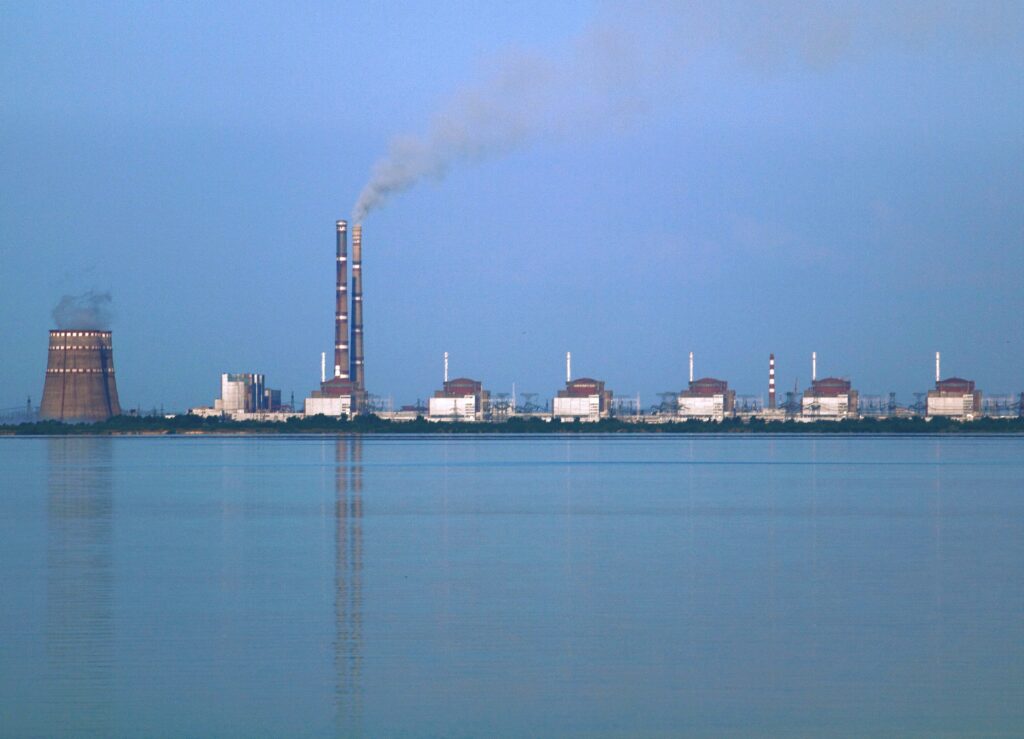At the Heinrich-Böll-Stiftung in Berlin, several international experts including two from Ukraine, underscored the precarious events unfolding at Ukraine’s nuclear power stations, among them the Zaporizhzhia complex, the largest nuclear power facility in Europe.

Zaporizhzhia Nuclear Power Plant. Credits: Ralf1969 | Wikimedia, CC BY-SA 3.0.
During the 15-month Russian attack on Ukraine, all of Ukraine’s four nuclear power stations – boasting 15 reactors and energy generation ranking it seventh in the world – have come under fire and experienced power losses, Ukrainian nuclear energy experts, Victoria Voytsitska, former Ukrainian parliament MP and chairwoman of its energy committee, and Olexi Pasyuk of Ecoaction Ukraine, told European Parliament members and journalists on April 26 in Berlin.
Voytsitska contends that Russia’s strategy is to apply military pressure to these stations with the intent of “inducing a catastrophic meltdown.” The plant most in danger is the Zaporizhzhia station in southeastern Ukraine, the largest nuclear plant in Europe and since early March under Russian control.
None of Ukraine’s reactors are prepared for military conflict, said Voytsitska, who added, “We’ve been very lucky thus far.” Attacks and fighting in and around the reactors have put their cooling systems at risk on many occasions, a charge that International Atomic Energy Agency (IAEA) officials substantiate. The Zaporizhzhia station has experienced six blackouts forcing the reactors to rely on diesel generators to run cooling equipment.
The most perilous moments thus far, said Voytsitska, unfolded on November 23, 2022, when the off-site power of all four plants was either cut off or experienced critical situations due to damaged grid infrastructure as a result of Russian shelling that targeted the plants’ electricity supplies.
All nuclear sites require secure off-site power from the grid to run their coolant systems, even when the stations are not running. “If a reactor loses the capability to cool itself, it could begin melting down within an hour’s time,” Voytsitska said. Since nuclear stations can rely on emergency diesel generators for back-up electricity for only a limited period of time – about ten days – power outages can quickly become dangerous.
Power also maintains services such as systems control, lighting, communication, and ventilation at the site.
“Not only did these Ukrainian stations have to resort to generators, but of Zaporizhzhia’s 20 generators two malfunctioned, which cut down the duration for which they could run,” says Voytsitska. It was only a matter of time before meltdown commenced, she says. But power was restored and disaster averted.
The New York Times recounted the week of shelling in mid-November in these terms: “Energy officials, gathered in a secret bunker in Kyiv, watched alarms flash on the large screens mapping the country’s energy grid as critical substations, thermal power plants and hydroelectric facilities all went dark. Then something happened they had never seen before over weeks of bombardment: All of the nation’s nuclear power plants were thrown into blackout. Within seconds, control rods positioned above reactors at Ukraine’s three working plants dropped into cores to absorb neutrons and stop the chain reaction that could lead to a meltdown.”
Ukrainian officials, reported the Times’s Marc Santora, were discussing mass evacuations.
On March 28, 1979, one reactor at the Three Mile Island plant near Pennsylvania’s capital, Harrisburg, began meltdown in a similar way when a stuck valve allowed large amounts of reactor coolant to escape. Radioactive gases and radioactive iodine escaped into the environment.
Although no one was killed or injured during the incident, it counts as the most serious accident in US commercial nuclear power plant history. “A combination of equipment malfunctions, design-related problems and worker errors led to [one reactor’s] partial meltdown…,” according to the US Nuclear Regulatory Commission. The Netflix documentary series “Meltdown: Three Mile Island” retells the story, showing that the afflicted unit came within half an hour from total melt down, a catastrophe that would have exposed hundreds of thousands in the vicinity to radioactivity.
Ukraine’s Voytsitska charges that Russia has and continues to target Ukrainian energy infrastructural in a deliberate attempt to prompt a dangerous nuclear incident. She is particularly worried about the targeting of grid substations, which transmit electricity to urban and industrial centers at different voltages. When a substation is out of operation, power no longer flows beyond it.
“Since nuclear power stations can’t be shut down easily,” she says, “there is no outlet for nuclear power to be distributed through the rest of the network. As a result, energy builds up and it bounces back and forth between the two possible energy endpoints: the rector and the substation. If enough energy builds up between the reactor and the substation, the whole system could crash.”
Expert Amy J. Nelson at the US Brookings think tank echoes Voytsitska’s warning: “So far, power outages have been handled by sourcing electricity from a coal-fired thermal power station and diesel generators. But if the final remaining power line from the national grid is damaged, on-site diesel generators cannot cool fuel in each of the plant’s six reactors in the long term. Should these backup generators fail, the subsequent loss of coolant could trigger a fuel meltdown.”
This worst-case scenario is compounded by heavy fighting around the reactor sites. Moreover, a Russian occupation team has replaced most but not all of the Ukrainian staff at the Zaporizhzhia plant.
The IAEA is monitoring the situation at the Zaporizhzhia plant where it claims to have secured a security zone around the plant and is now attempting to reach a further agreement with the Russian occupiers on protection of the plant.
In Berlin at the Böll foundation briefing, Voytsitska and Pasyuk questioned whether it was possible at all to establish security in the midst of such heavy fighting. They criticized Western governments for not sanctioning the Russian nuclear service provider Rosatom, which furnishes uranium and other materials to many reactors in western Europe and all of those in eastern central Europe.
Note: this article was edited on 10 May 2023.